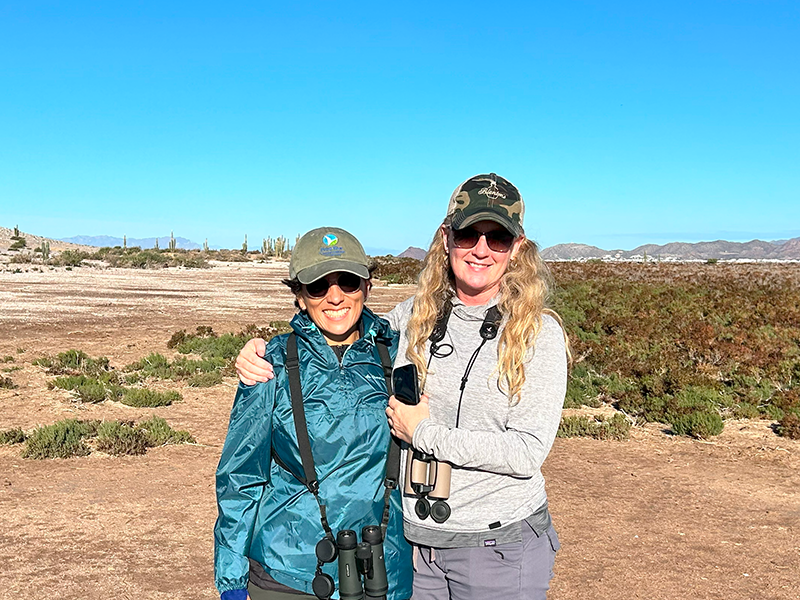By Catherine Hickey, Director of Pacific Coast and Central Valley Group; Liz Chamberlin, Director of Innovation; and Diana Eusse, Program Coordinator
There’s nothing quite like the thrill of launching a new program. And there’s really nothing like getting out from behind our computer screens and out into the field. The three of us recently returned from a site visit to Kino Bay in Mexico where we completed a site visit filled with amazing scenery, diverse wildlife sightings (including bottle-nosed dolphins and over 250 snowy plovers), and rewarding relationship building with local partners.

For over 13 years, we’ve been working with partners from 13 countries along the Pacific Coast of the Americas from Alaska to Chile as part of the Migratory Shorebird Project (MSP). MSP works with partners of the 13 countries to coordinate data collection about migrating shorebirds, and use this data to advance conservation goals. In 2023 we entered the pilot phase for a new program, MSP+ Science to Action, a grantmaking program housed at Point Blue that springs from the science and partnerships we have built from our decade of work with the MSP. The program will direct financial support to partners in Latin America to build capacity and support their conservation efforts. In the pilot phase, we made grants to partners in Mexico, Guatemala, El Salvador, Nicaragua, and Chile. As we prepare for the launch of our full MSP+ program later this spring, we were excited to check in and see how their projects were doing.

Our visit to Kino Bay (part of Mexico’s Sonoran coast) was our first site visit with an MSP+ grant partner. Our partner, the Prescott College Kino Bay Center for Cultural and Ecological Studies (the Center), is a bi-national non-profit organization with a 30-year history of monitoring, conservation and successful community collaboration. The Center has conducted waterbird and marine mammal monitoring studies in the region since 2009 and has used the data and information from these studies to protect habitat through the designation and collaborative management of Ramsar Sites and IBAs, designations to support wetlands conservation. The Center currently trains and supports local and indigenous community members to participate in and lead migratory bird monitoring and conservation projects.
In their own words, the goal of their MSP+ project is to: “advance community-based conservation of waterbird habitat in two designated Ramsar sites adjacent to local and indigenous communities in coastal Sonora, Mexico. The ultimate vision of this work is twofold; firstly to foment a durable and active coalition of community members engaged in conservation work at the local level, and secondly, to create equitable relationships between local stakeholders and resource managers at the local, state, and federal level that can result in meaningful conservation outcomes for important wetland habitats and the birds, ecosystems, and human communities that rely on them.”

The three of us spent two glorious days touring the sites and getting to know the area and the people. On the first day, groups of bottle-nosed dolphins surfed in the wake on the bow of our boat. On the second day, we traveled hours by boat, passing thousands of Brant and rafts of Eared Grebes on the water, to survey shorebirds at El Sargento – data that contributes to the MSP. We were beyond excited to encounter a flock of ~250 Snowy Plovers (we searched about half of the birds for bands but did not find any), along with American Oystercatchers, Long-billed Curlews, Willets, Sanderling, Western Sandpipers, Greater Yellowlegs, Marbled Godwit, and Wilson’s Plovers.
But absolutely one of the most beautiful and unforgettable parts of the trip was, during lunch break on a sand spit, being sung a welcome song by one of our Comcaac community hosts and now partners!
The landscape was breathtaking, and we were blown away to see and participate first-hand in understanding the critical work of the Center. It was incredible to see how they not only conduct rigorous science but also provide effective community engagement to drive science-based conservation action on the ground in the region. MSP+ supports the work of individual grantees like the Center but also true multinational collaboration and networking.

Our time in Kino Bay was one of the highlights of our time with Point Blue, and we were so pleased to hear that our partners appreciate working with us. Lorayne Meltzer, the Executive Director of the Center said to us, unprompted, “It has been so refreshing working with Diana, Catherine, and Matt as MSP+ grantees. We look forward to our check-ins with the MSP+ team because we come away having learned something, with new ideas and support to help improve our work. We love the collaborative model of the MSP+.”
As we officially launch the MSP+ program this spring, we’ll be visiting additional grant partners and reporting back as we do. Stepping into the world of collaborative and inclusive grantmaking is an exciting moment for Point Blue, one that reflects nearly 60 years of learning about conservation science, partner engagement, and strategy design. We’re excited to share more about this program soon and look forward to sharing more updates from the field!

